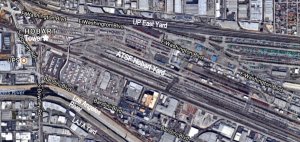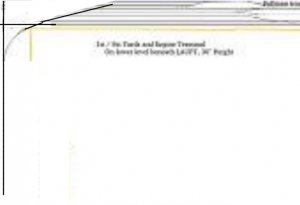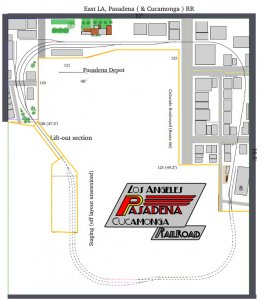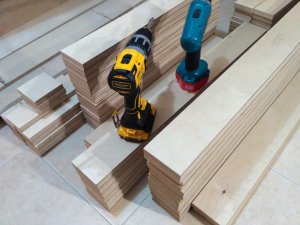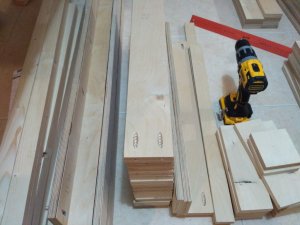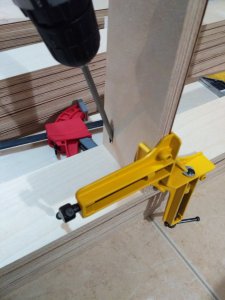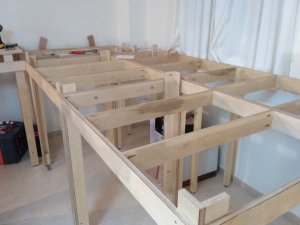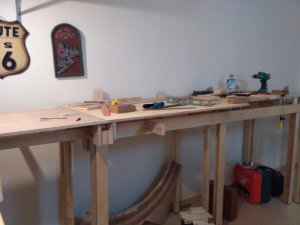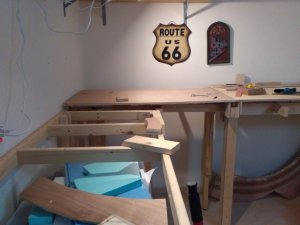Good morning everyone!
Following good advice from fellow modelers, reading and research, i have settled on track-plans for two layouts. One for a future space/home, and one for my current home. Key point here is that the current one is derived from the future one. I started off with what i really liked/wanted in order to produce the track plan for the future one, and then using modules (inspired by modules and the TOMA approach from MRH) i ended up with the much smaller version for the current space.
Using this method, i will be able to start working on the future layout from now instead of waiting for the future home to materialize. The layout for the current space is seen on the lower left corner of the image i attach. The red rectangles (numbered 1 to 7) on the layouts represent the modules i am talking about. The rest of the track/bench on the current-space plan, is not going to be transfered to the new space and i am only going to salvage track and possibly some scenic material.
For the layout concept:
ATSF LA Division, covering part of the 2nd district. 1964 to 1968. Upper main level height at 50"-54", lower level 30" (yards and staging). 40" Minimum radius for curves viewed from the outside, 36" elsewhere (got to run 85' cars mainly and they should look as good as possible).
Starting from 8th/1st street yards (compressed to being side by side), off to the west helix and up to the main level where a wye leads to either LAUPT or the mainline to the east.This west helix is connected to lower level staging as well, offering continuous run option.
Following the mainline eastwards, the scenes are:
1. LA river crossing (Truss bridge scene)
2. Arroyo Seco Bridge (Trestle bridge scene)
3. South Pasadena (possibly industrial action inside the dogbone loop).
4. Pasadena Depot
5. Colorado Boulevard / Route 66. Here the train hides behind buildings and becomes the "background" seen between buildings and the main focus is the boulevard itself with the buildings.
6. North Pasadena Industrial area
7. San Dimas (might scrap this and have a plain rural area here instead, with a couple of industries)
8. Cucamonga (Art Deco depot, Winery and Packing house planned along with representing Route 66)
and off to east-helix down to east staging which is below the North Pasadena Industrial area on the right side of the layout.
The smaller layout, for the current space will include a few parts of this bigger plan. These include the Pasadena depot, part of Colorado Blvd and part of Cucamonga.
The larger layout is designed with the principle to keep things simple but less compressed. In other words, having the larger size as a result of more expansive and less compressed (few) scenes instead of many scenes and complex trackwork. Hopefully this idea / principle will keep things manageable despite the larger size. I have read that the complexity makes things difficult to handle/build/maintain and not the length of the track/scene.
Trains operating:
East/West bound local freights. The main freight players here, originating at 1st street yard in LA, going to San Bernardino and back.
Eastbound Pickup Extra. Dealing with reefers from LA to SB. (optional train for variety)
Steel Extra. SB to LA, hauling product from Kaiser steel to LA (optional train for variety)
Super Chief, El-Cap and Chief as well as the 2nd district local LA-SB train (discontinued by then...fictionally re-activated in my layout).
Many thanks for your previous advices in track planning that helped me getting here.
Yannis
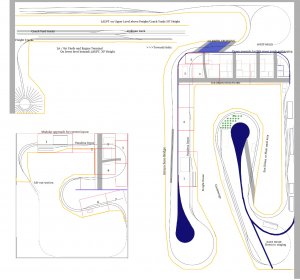
Following good advice from fellow modelers, reading and research, i have settled on track-plans for two layouts. One for a future space/home, and one for my current home. Key point here is that the current one is derived from the future one. I started off with what i really liked/wanted in order to produce the track plan for the future one, and then using modules (inspired by modules and the TOMA approach from MRH) i ended up with the much smaller version for the current space.
Using this method, i will be able to start working on the future layout from now instead of waiting for the future home to materialize. The layout for the current space is seen on the lower left corner of the image i attach. The red rectangles (numbered 1 to 7) on the layouts represent the modules i am talking about. The rest of the track/bench on the current-space plan, is not going to be transfered to the new space and i am only going to salvage track and possibly some scenic material.
For the layout concept:
ATSF LA Division, covering part of the 2nd district. 1964 to 1968. Upper main level height at 50"-54", lower level 30" (yards and staging). 40" Minimum radius for curves viewed from the outside, 36" elsewhere (got to run 85' cars mainly and they should look as good as possible).
Starting from 8th/1st street yards (compressed to being side by side), off to the west helix and up to the main level where a wye leads to either LAUPT or the mainline to the east.This west helix is connected to lower level staging as well, offering continuous run option.
Following the mainline eastwards, the scenes are:
1. LA river crossing (Truss bridge scene)
2. Arroyo Seco Bridge (Trestle bridge scene)
3. South Pasadena (possibly industrial action inside the dogbone loop).
4. Pasadena Depot
5. Colorado Boulevard / Route 66. Here the train hides behind buildings and becomes the "background" seen between buildings and the main focus is the boulevard itself with the buildings.
6. North Pasadena Industrial area
7. San Dimas (might scrap this and have a plain rural area here instead, with a couple of industries)
8. Cucamonga (Art Deco depot, Winery and Packing house planned along with representing Route 66)
and off to east-helix down to east staging which is below the North Pasadena Industrial area on the right side of the layout.
The smaller layout, for the current space will include a few parts of this bigger plan. These include the Pasadena depot, part of Colorado Blvd and part of Cucamonga.
The larger layout is designed with the principle to keep things simple but less compressed. In other words, having the larger size as a result of more expansive and less compressed (few) scenes instead of many scenes and complex trackwork. Hopefully this idea / principle will keep things manageable despite the larger size. I have read that the complexity makes things difficult to handle/build/maintain and not the length of the track/scene.
Trains operating:
East/West bound local freights. The main freight players here, originating at 1st street yard in LA, going to San Bernardino and back.
Eastbound Pickup Extra. Dealing with reefers from LA to SB. (optional train for variety)
Steel Extra. SB to LA, hauling product from Kaiser steel to LA (optional train for variety)
Super Chief, El-Cap and Chief as well as the 2nd district local LA-SB train (discontinued by then...fictionally re-activated in my layout).
Many thanks for your previous advices in track planning that helped me getting here.
Yannis


